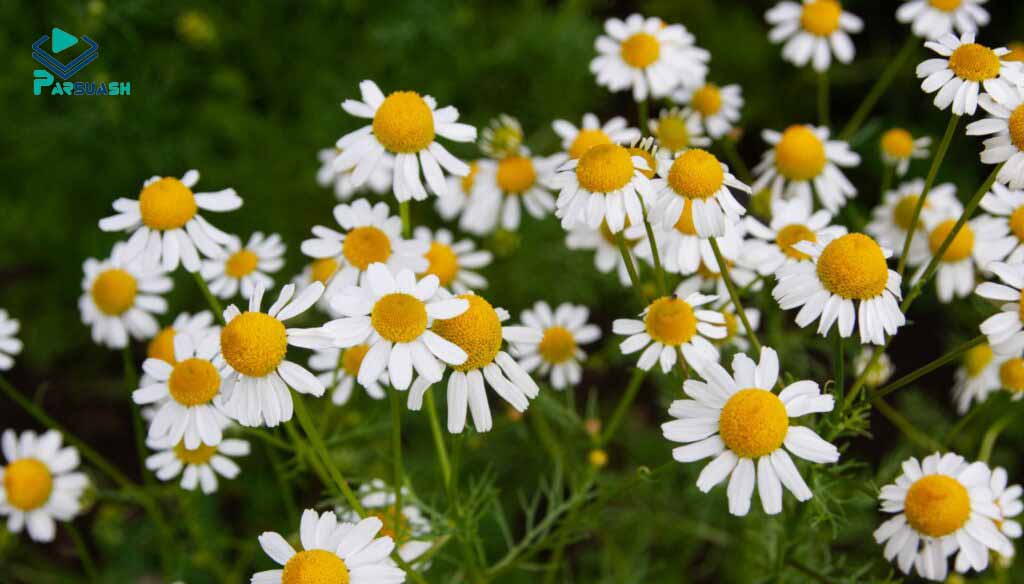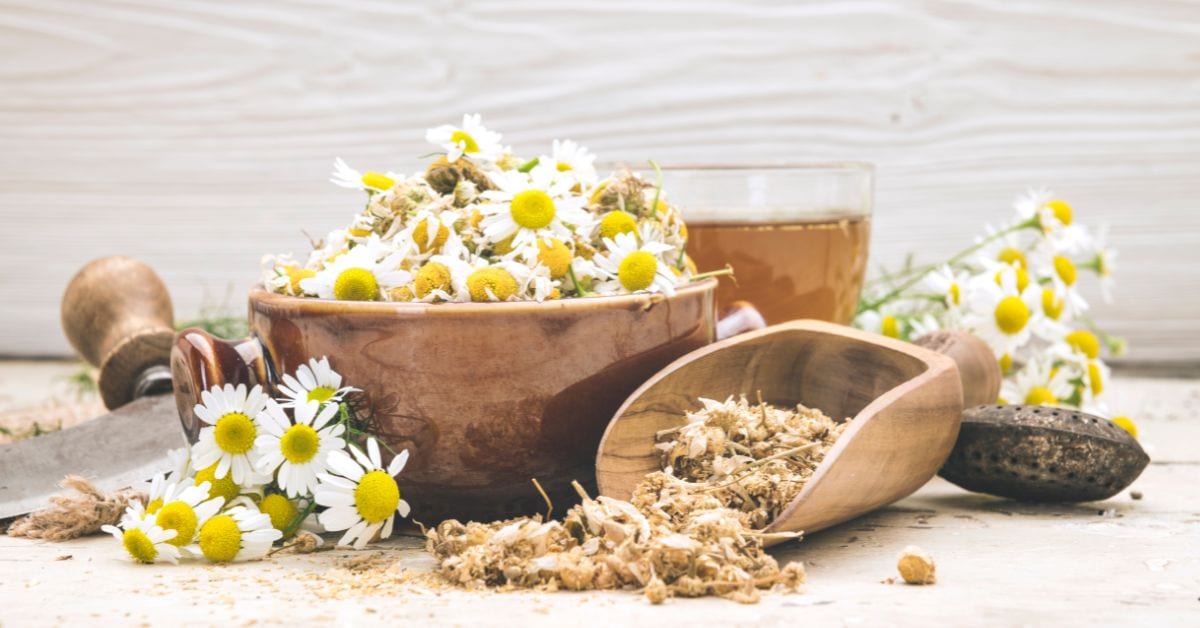
Table of Contents
Chamomile is a medicinal plant with high economic value, which has many uses in the pharmaceutical, cosmetic and health industries. The flowers of chamomile are used to treat diseases such as heartache, flatulence, skin wounds, and also as a suitable remedy for inflammation. Chamomile is also widely used in the cosmetic industry in the production of shampoos, creams and lotions.
Chamomile is one of the plants that can grow in different environmental conditions and in different waters and soils. This plant can be grown in almost all areas, except in areas with very high salinity. It should be noted that chamomile is one of the few medicinal plants that tolerates brackish water well and can be grown in these areas. Iranian chamomile is known for its high quality and is sought after by buyers around the world. The chamomile produced in Iran is typically harvested by hand and dried in the sun, which helps to preserve its delicate aroma and flavor.
Properties of chamomile
Chamomile has been used in traditional medicine for centuries to treat a variety of conditions, including anxiety, insomnia, digestive problems, and skin disorders. Chamomile contains several active ingredients, including camazolin, apigenin and bisabolol, which have anti-inflammatory, antiseptic and sedative properties.
Chamomile is usually drunk as a tea made from dried chamomile flowers. Chamomile tea is often used to relax, relieve stress and anxiety, and improve sleep. It can also be used topically to soothe irritated skin, or as a natural hair wash to promote healthy hair and scalp.
In addition to its use as a tea, chamomile is also available in various forms, including capsules, tinctures, and essential oils. Chamomile essential oil is often used in aromatherapy to promote relaxation and relieve stress and anxiety.
In general, chamomile is a versatile and widely used plant that has long been used in traditional medicine. Its potential health benefits and soothing properties make it a popular choice for those seeking natural remedies for a variety of ailments.
Chamomile planting conditions
Chamomile is compatible with almost all climates except very cold ones. Chamomile has few soil requirements and can thrive in most soils, but it does best in soils of medium texture with abundant nutrients and sufficient fresh water. German chamomile is classified as a medicinal plant with low water requirements and can tolerate brackish water. Due to its suitable planting time in late autumn, it makes optimal use of autumn and winter precipitation for its growth.
Chamomile needs plenty of light and full sun during growth and flowering. Chamomile can be grown in both fall and spring. Due to the good winter cold tolerance of the plant, the autumn cultivation of the plant has the preference over the spring cultivation, because the plant growth begins in the fall, the atmospheric precipitation is used and the yield is higher.
Iranian Chamomile
In Iran, it grows wild in the northern regions, also in Khuzestan (Dezful and Shushtar) and in Fars (Kazron). This plant is cultivated in Isfahan, Lorestan, Chaharmahal, Bakhtiari and Tehran.
.

Shirazi Chamomile
Roman chamomile (Chamaemelum nobile) is a perennial plant native to Western Europe and Northern Ireland. Tea made from Roman chamomile is traditionally used to treat digestive disorders such as nausea, flatulence, vomiting, and heartburn. It is also known for its anti-inflammatory properties and is used to relieve inflammation on the skin.
In the traditional books of Iran, this chamomile is also called Shirazi chamomile. The nature of Roman chamomile is hot and dry. The properties of Roman chamomile include calming and strengthening the nerves and increasing sexual power; it has been considered antipyretic and antichills since ancient times; it is suitable for regulating menstruation, increases milk secretion, and is used to relieve headaches and reduce swelling. It is also useful in breaking up bladder stones and can be very helpful in urinary tract obstruction and low menstrual flow.
Chamomile HS code
The HS code for chamomile varies depending on the form in which it is imported or exported, as well as the country of origin and destination. However, here are some possible HS codes that could apply to chamomile:
Dried chamomile flowers: HS code 1211
Chamomile tea bags: HS code 0902
Chamomile extracts and tinctures: HS code 1302
Chamomile essential oil: HS code 3301
It is important to note that these codes are for informational purposes only and that the final HS code will depend on the specific product being traded and the applicable customs regulations in each country. It is recommended to consult with a customs broker or import/export specialist to determine the correct HS code for a particular product.
.
Suggested article: Export potential of Iran: Pistachio export
The importers of chamomile
The largest importers of chamomile in the world vary by year and source of data, but here are some countries that are consistently among the top importers:
Germany: Germany is one of the largest importers of chamomile in the world, both as a raw material and in processed forms such as chamomile tea and chamomile extracts. Demand for chamomile in Germany is driven by the country’s strong tradition of using herbal remedies and natural products.
United States: The United States is also a major importer of chamomile, particularly for use in the natural health and wellness industry. In the U.S., chamomile is used in a variety of products, including teas, dietary supplements, and personal care products.
United Kingdom: The United Kingdom is another major importer of chamomile, both as a raw material and in processed forms such as tea and essential oil. hamomile is popular in the UK for its calming and soothing properties and is used in a variety of products, including skin and hair care products and aromatherapy.
France: France is a major importer of chamomile for use in the cosmetics and personal care industries. In France, chamomile is used in a variety of skin care products for its anti-inflammatory and soothing properties.
Japan: Japan is a growing market for chamomile, especially for use in cosmetics and personal care products. Chamomile is also used in traditional Japanese medicine for its soothing and relaxing properties.
It should be noted that chamomile is imported by many other countries around the world and the largest importers may vary from year to year depending on factors such as supply and demand, pricing, and changing consumer preferences.
.

The exporters of chamomile
The largest exporters of chamomile in the world vary depending on the year and the source of the data, but here are some countries that are consistently among the top exporters:
Egypt: Egypt is the largest exporter of chamomile in the world, accounting for a significant portion of global chamomile production. The country’s favorable climate and soil conditions make it well-suited for growing chamomile, and the herb is a major export crop for the country.
Germany: Germany is both a major importer and exporter of chamomile, and is known for producing high-quality chamomile extracts and essential oils. German chamomile is highly sought after for its potent anti-inflammatory and calming properties.
France: France is a significant exporter of chamomile essential oil, which is used in a variety of products in the cosmetics and personal care industry. French chamomile is known for its sweet, fruity aroma and is considered to be a premium grade essential oil.
Hungary: Hungary is a major exporter of chamomile, particularly for use in teas and herbal remedies. Hungarian chamomile is known for its delicate, floral aroma and is highly valued for its calming and soothing properties.
Bulgaria: Bulgaria is a significant exporter of chamomile, particularly for use in the cosmetics and personal care industry. Bulgarian chamomile is known for its high levels of chamazulene, a compound that gives chamomile its blue color and has anti-inflammatory properties.
There are several other countries that are emerging as major chamomile exporters.
Albania: Albania has been increasing its chamomile production in recent years and is becoming a significant exporter of the herb. Chamomile is a traditional crop in Albania and is grown in the southern regions of the country. The chamomile produced in Albania is known for its high quality and is sought after by buyers around the world.
Morocco: Morocco is also becoming a significant exporter of chamomile, particularly for use in the cosmetics and personal care industry. Moroccan chamomile is known for its high levels of chamazulene and is considered to be a premium grade essential oil.
India: India has a long history of using chamomile in traditional medicine and is now exporting the herb to other countries. Indian chamomile is known for its delicate aroma and is used in a variety of products, including teas, supplements, and cosmetics.
Argentina: Argentina is another country that is increasing its chamomile production and exports. Chamomile is grown in the northern regions of the country and is used in a variety of products, including teas, supplements, and cosmetics.
Overall, the global demand for chamomile is increasing, and more countries are recognizing the economic potential of growing and exporting the herb. As a result, we may see more countries emerging as major chamomile exporters in the future.
Iran capability for exporting chamomile
Iran has the capability to export chamomile and is one of the major producers of chamomile in the world. Chamomile is grown in several provinces throughout Iran, including Khorasan, Fars, and Isfahan, and the country has a long history of using chamomile in traditional medicine.
Iranian chamomile is known for its high quality and is sought after by buyers around the world. The chamomile produced in Iran is typically harvested by hand and dried in the sun, which helps to preserve its delicate aroma and flavor.
Chamomile is exported from Iran in several forms, including dried flowers, tea, and essential oil. According to data from the Iranian Ministry of Agriculture, Iran exported over 1,500 tons of chamomile in the year 2019, with the majority of exports going to countries in Europe and the Middle East.
.

Global demand for chamomile
There are several factors contributing to the increasing global demand for chamomile:
Growing interest in natural and herbal remedies: As consumers become more interested in natural and herbal remedies, chamomile is becoming more popular due to its calming and soothing properties. Chamomile is used in a variety of products, including teas, supplements, and skincare, and is considered to be a safe and effective natural remedy for a variety of ailments.
Increasing demand for natural and organic products: As more consumers seek out natural and organic products, chamomile is becoming a popular ingredient in these products. Chamomile is a natural, plant-derived ingredient that is free from synthetic chemicals and is therefore well-suited for use in natural and organic products.
Growing awareness of the health benefits of chamomile: Chamomile has been used for centuries in traditional medicine to treat a variety of ailments, and recent research has confirmed many of its potential health benefits. Chamomile is believed to have anti-inflammatory, antispasmodic, and calming properties, making it a popular choice for those looking for natural remedies for conditions such as anxiety, insomnia, and digestive problems.
Increasing demand in the cosmetics and personal care industry: Chamomile is a popular ingredient in the cosmetics and personal care industry, where it is used in a variety of products such as skincare, hair care, and aromatherapy. Chamomile is known for its anti-inflammatory and soothing properties, making it a popular choice for products designed to calm and soothe the skin or scalp.
Overall, the increasing global demand for chamomile is driven by a combination of factors, including growing consumer interest in natural and herbal remedies, increasing demand for natural and organic products, and growing awareness of the health benefits of chamomile.
